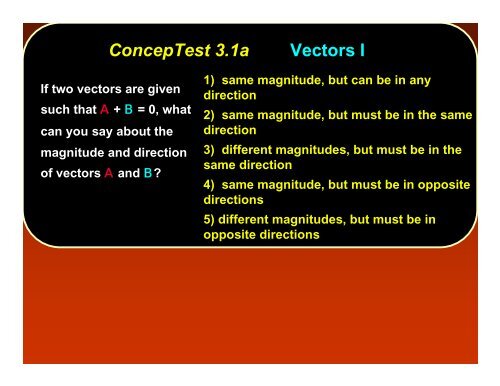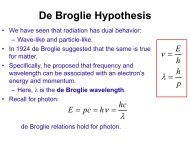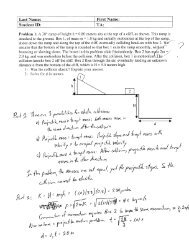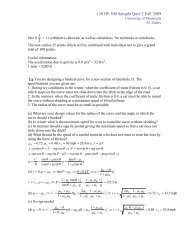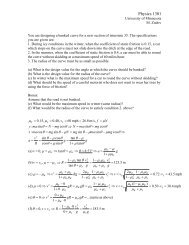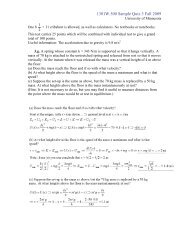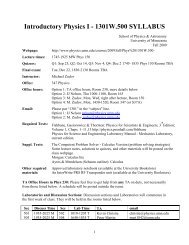ConcepTest 3.1a Vectors I
ConcepTest 3.1a Vectors I
ConcepTest 3.1a Vectors I
- No tags were found...
Create successful ePaper yourself
Turn your PDF publications into a flip-book with our unique Google optimized e-Paper software.
<strong>ConcepTest</strong> <strong>3.1a</strong> <strong>Vectors</strong> IIf two vectors are givensuch that A + B = 0, whatcan you say about themagnitude and directionof vectors A and B?1) same magnitude, but can be in anydirection2) same magnitude, but must be in the samedirection3) different magnitudes, but must be in thesame direction4) same magnitude, but must be in oppositedirections5) different magnitudes, but must be inopposite directions
<strong>ConcepTest</strong> <strong>3.1a</strong> <strong>Vectors</strong> IIf two vectors are givensuch that A + B = 0, whatcan you say about themagnitude and directionof vectors A and B?1) same magnitude, but can be in anydirection2) same magnitude, but must be in the samedirection3) different magnitudes, but must be in thesame direction4) same magnitude, but must be in oppositedirections5) different magnitudes, but must be inopposite directionsThe magnitudes must be the same, but one vector must be pointing inthe opposite direction of the other, in order for the sum to come out tozero. You can prove this with the tip-to-tail method.
<strong>ConcepTest</strong> 3.1b <strong>Vectors</strong> IIGiven that A + B = C, andthat lAl 2 + lBl 2 = lCl 2 ,how are vectors A and Boriented with respect toeach other?1) they are perpendicular to each other2) they are parallel and in the same direction3) they are parallel but in the oppositedirection4) they are at 45° to each other5) they can be at any angle to each other
<strong>ConcepTest</strong> 3.1b <strong>Vectors</strong> IIGiven that A + B = C, andthat lAl 2 + lBl 2 = lCl 2 ,how are vectors A and Boriented with respect toeach other?1) they are perpendicular to each other2) they are parallel and in the same direction3) they are parallel but in the oppositedirection4) they are at 45° to each other5) they can be at any angle to each otherNote that the magnitudes of the vectors satisfy the PythagoreanTheorem. This suggests that they form a right triangle, with vector Cas the hypotenuse. Thus, A and B are the legs of the right triangle andare therefore perpendicular.
<strong>ConcepTest</strong> 3.1c <strong>Vectors</strong> IIIGiven that A + B = C,and that lAl + lBl =lCl , how are vectorsA and B oriented withrespect to eachother?1) they are perpendicular to each other2) they are parallel and in the same direction3) they are parallel but in the opposite direction4) they are at 45° to each other5) they can be at any angle to each other
<strong>ConcepTest</strong> 3.1c <strong>Vectors</strong> IIIGiven that A + B = C,and that lAl + lBl =lCl , how are vectorsA and B oriented withrespect to eachother?1) they are perpendicular to each other2) they are parallel and in the same direction3) they are parallel but in the opposite direction4) they are at 45° to each other5) they can be at any angle to each otherThe only time vector magnitudes will simply add together is when thedirection does not have to be taken into account (i.e., the direction isthe same for both vectors). In that case, there is no angle betweenthem to worry about, so vectors A and B must be pointing in thesame direction.
<strong>ConcepTest</strong> 3.2a Vector Components IIf each component of avector is doubled, whathappens to the angle ofthat vector?1) it doubles2) it increases, but by less than double3) it does not change4) it is reduced by half5) it decreases, but not as much as half
<strong>ConcepTest</strong> 3.2a Vector Components IIf each component of avector is doubled, whathappens to the angle ofthat vector?1) it doubles2) it increases, but by less than double3) it does not change4) it is reduced by half5) it decreases, but not as much as halfThe magnitude of the vector clearly doubles if each of itscomponents is doubled. But the angle of the vector is given by tanθ = 2y/2x, which is the same as tan θ = y/x (the original angle).Follow-up:If you double one component and notthe other, how would the angle change?
<strong>ConcepTest</strong> 3.2b Vector Components IIA certain vector has x and y componentsthat are equal in magnitude. Which of thefollowing is a possible angle for thisvector, in a standard x-y coordinatesystem?1) 30°2) 180°3) 90°4) 60°5) 45°
<strong>ConcepTest</strong> 3.2b Vector Components IIA certain vector has x and y componentsthat are equal in magnitude. Which of thefollowing is a possible angle for thisvector, in a standard x-y coordinatesystem?1) 30°2) 180°3) 90°4) 60°5) 45°The angle of the vector is given by tan θ = y/x. Thus, tan θ = 1in this case if x and y are equal, which means that the anglemust be 45°.
<strong>ConcepTest</strong> 3.3 Vector AdditionYou are adding vectors of length20 and 40 units. What is the onlypossible resultant magnitude thatyou can obtain out of thefollowing choices?1) 02) 183) 374) 645) 100
<strong>ConcepTest</strong> 3.3 Vector AdditionYou are adding vectors of length20 and 40 units. What is the onlypossible resultant magnitude thatyou can obtain out of thefollowing choices?1) 02) 183) 374) 645) 100The minimum resultant occurs when the vectorsare opposite, giving 20 units. The maximumresultant occurs when the vectors are aligned,giving 60 units. Anything in between is alsopossible, for angles between 0° and 180°.


